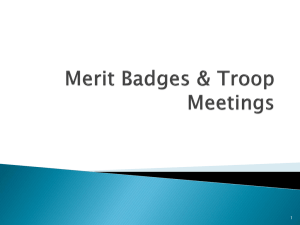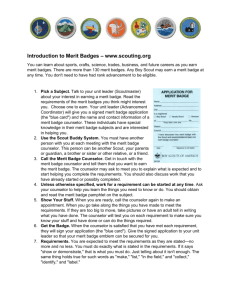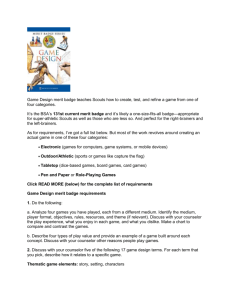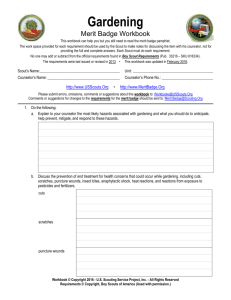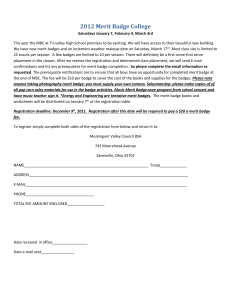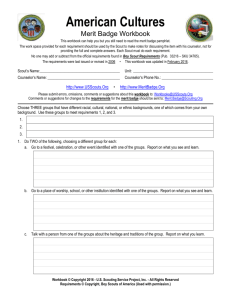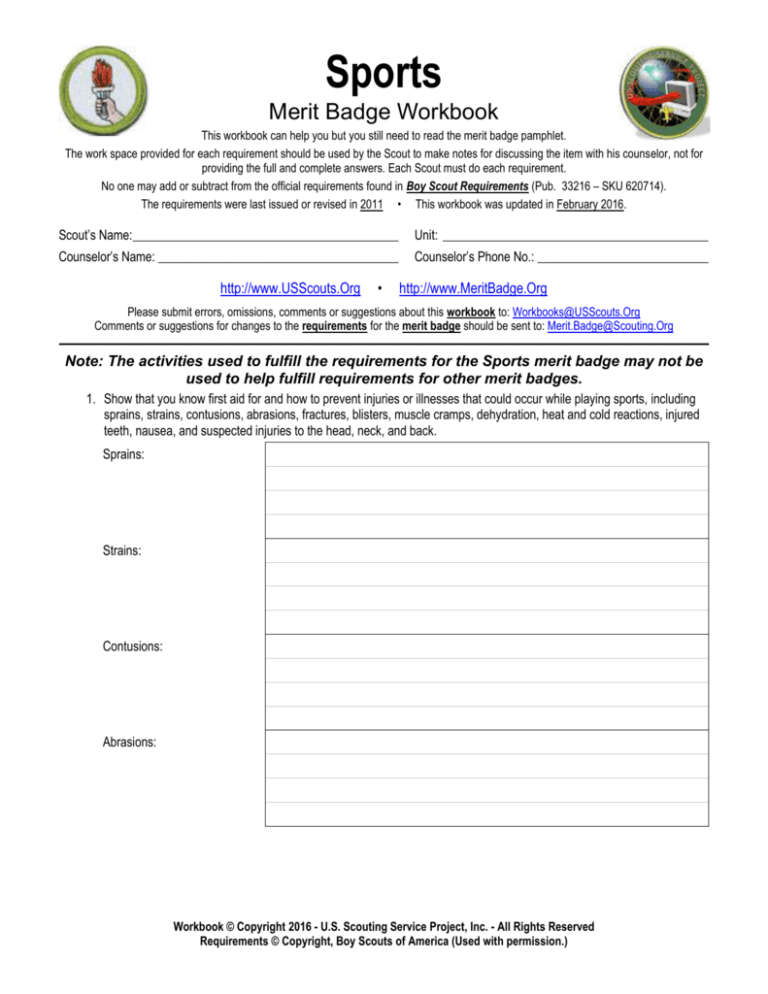
Sports
Merit Badge Workbook
This workbook can help you but you still need to read the merit badge pamphlet.
The work space provided for each requirement should be used by the Scout to make notes for discussing the item with his counselor, not for
providing the full and complete answers. Each Scout must do each requirement.
No one may add or subtract from the official requirements found in Boy Scout Requirements (Pub. 33216 – SKU 620714).
The requirements were last issued or revised in 2011 • This workbook was updated in February 2016.
Scout’s Name:__________________________________________
Unit: __________________________________________
Counselor’s Name: ______________________________________
Counselor’s Phone No.: ___________________________
http://www.USScouts.Org
•
http://www.MeritBadge.Org
Please submit errors, omissions, comments or suggestions about this workbook to: Workbooks@USScouts.Org
Comments or suggestions for changes to the requirements for the merit badge should be sent to: Merit.Badge@Scouting.Org
______________________________________________________________________________________________________________________________________________
Note: The activities used to fulfill the requirements for the Sports merit badge may not be
used to help fulfill requirements for other merit badges.
1. Show that you know first aid for and how to prevent injuries or illnesses that could occur while playing sports, including
sprains, strains, contusions, abrasions, fractures, blisters, muscle cramps, dehydration, heat and cold reactions, injured
teeth, nausea, and suspected injuries to the head, neck, and back.
Sprains:
Strains:
Contusions:
Abrasions:
Workbook © Copyright 2016 - U.S. Scouting Service Project, Inc. - All Rights Reserved
Requirements © Copyright, Boy Scouts of America (Used with permission.)
Sports
Scout's Name: ________________________
Fractures:
Blisters:
Muscle cramps:
Dehydration:
Heat and cold reactions:
Injured teeth:
Nausea:
Suspected injuries to the head:
Sports - Merit Badge Workbook
Page. 2 of 12
Sports
Scout's Name: ________________________
Suspected injuries to the neck:
Suspected injuries to the back:
2. Explain the importance of the following:
a. The importance of the physical exam
b. The importance of maintaining good health habits for life (such as exercising regularly), and how the use of tobacco
products, alcohol, and other harmful substances can negatively affect your health and your performance in sports
activities.
Maintaining good health habits:
Use of tobacco products:
Sports - Merit Badge Workbook
Page. 3 of 12
Sports
Scout's Name: ________________________
Use of alcohol:
Use of other harmful substances:
c. The importance of maintaining a healthy diet
3. Discuss the following:
a. The importance of warming up and cooling down
Sports - Merit Badge Workbook
Page. 4 of 12
Sports
Scout's Name: ________________________
b. The importance of weight training
c. What an amateur athlete is and the differences between an amateur and a professional athlete
d. The attributes (qualities) of a good sport, the importance of sportsmanship, and the traits of a good team leader and
player who exhibits Scout spirit on and off the playing field.
Attributes (qualities) of a good sport:
The importance of sportsmanship:
Sports - Merit Badge Workbook
Page. 5 of 12
Sports
Scout's Name: ________________________
The traits of a good team leader and player:
4. Take part for one season (or four months) as a competitive individual or as a member of an organized team in TWO of
the following sports: baseball, basketball, bowling, cross-country, field hockey, football, ice hockey, lacrosse, soccer,
softball, table tennis, tennis, volleyball, water polo. Your counselor may approve in advance other recognized sports, but
not any sport that is restricted and not authorized by the Boy Scouts of America.
Baseball
Basketball
Bowling
Cross-Country
Field Hockey
Football
Ice Hockey
Lacrosse
Soccer
Softball
Table Tennis
Tennis
Volleyball
Water Polo
Sports - Merit Badge Workbook
Page. 6 of 12
Sports
Scout's Name: ________________________
Then with your chosen sports do the following:
a. Give the rules and etiquette for the two sports you picked.
b. List the equipment needed for the two sports you chose. Describe the protective equipment and appropriate
clothing (if any) and explain why it is needed.
c. Draw diagrams of the playing areas for your two sports.
Sport 1:
Season Began
Season Ended
a. Give the rules and etiquette
b. List the equipment needed.
Sports - Merit Badge Workbook
Page. 7 of 12
Sports
Scout's Name: ________________________
Describe the protective equipment and appropriate clothing (if any) and explain why it is needed.
c. Diagram
Sports - Merit Badge Workbook
Page. 8 of 12
Sports
Scout's Name: ________________________
Sport 1:
Season Began
Season Ended
a. Give the rules and etiquette
b. List the equipment needed.
Sports - Merit Badge Workbook
Page. 9 of 12
Sports
Scout's Name: ________________________
Describe the protective equipment and appropriate clothing (if any) and explain why it is needed.
c. Diagram
Sports - Merit Badge Workbook
Page. 10 of 12
Sports
Scout's Name: ________________________
5. With guidance from your counselor, establish a personal training program suited to the activities you chose for
requirement 4. Then do the following:
a. Organize a chart to track your training, practice, and development in these sports for one season (or four months).
Date (week)
Training, Practice, and Development
b. Demonstrate proper technique for your two chosen sports.
Sport 1
Sport 2
c. At the end of the season, share your completed chart with your counselor and discuss how your participation in the
sports you chose has affected you mentally and physically.
Requirement resources can be found here:
http://www.meritbadge.org/wiki/index.php/Sports#Requirement resources
Sports - Merit Badge Workbook
Page. 11 of 12
Important excerpts from the Guide To Advancement - 2015, No. 33088 (SKU-620573)
[1.0.0.0] — Introduction
The current edition of the Guide to Advancement is the official source for administering advancement in all Boy Scouts of America programs: Cub Scouting, Boy
Scouting, Varsity Scouting, Venturing, and Sea Scouts. It replaces any previous BSA advancement manuals and previous editions of the Guide to Advancement.
[Page 2, and 5.0.1.4] — Policy on Unauthorized Changes to Advancement Program
No council, committee, district, unit, or individual has the authority to add to, or subtract from, advancement requirements. There are limited exceptions
relating only to youth members with special needs. For details see section 10, “Advancement for Members With Special Needs”.
[Page 2] — The “Guide to Safe Scouting” Applies
Policies and procedures outlined in the Guide to Safe Scouting, No. 34416, apply to all BSA activities, including those related to advancement and Eagle Scout
service projects.
[7.0.3.1] — The Buddy System and Certifying Completion
A youth member must not meet one-on-one with an adult. Sessions with counselors must take place where others can view the interaction, or the Scout must have a
buddy: a friend, parent, guardian, brother, sister, or other relative—or better yet, another Scout working on the same badge—along with him attending the session. If
merit badge counseling or instruction includes any Web-based interaction, it must be conducted in accordance with the BSA Social Media Guidelines
(http://www.scouting.org/Marketing/Resources/SocialMedia). For example, always copy one or more authorized adults on email messages between counselors and
Scouts.
When the Scout meets with the counselor, he should bring any required projects. If these cannot be transported, he should present evidence, such as photographs or
adult verification. His unit leader, for example, might state that a satisfactory bridge or tower has been built for the Pioneering merit badge, or that meals were
prepared for Cooking. If there are questions that requirements were met, a counselor may confirm with adults involved. Once satisfied, the counselor signs the blue
card using the date upon which the Scout completed the requirements, or in the case of partials, initials the individual requirements passed.
Note that from time to time, it may be appropriate for a requirement that has been met for one badge to also count for another. See “Fulfilling More Than One
Requirement With a Single Activity,” 4.2.3.6.
[7.0.3.2] — Group Instruction
It is acceptable—and sometimes desirable—for merit badges to be taught in group settings. This often occurs at camp and merit badge midways, fairs, clinics, or
similar events. Interactive group discussions can support learning. The method can also be attractive to “guest experts” assisting registered and approved
counselors. Slide shows, skits, demonstrations, panels, and various other techniques can also be employed, but as any teacher can attest, not everyone will learn all
the material.
There must be attention to each individual’s projects and his fulfillment of all requirements. We must know that every Scout —actually and personally— completed
them. If, for example, a requirement uses words like “show,” “demonstrate,” or “discuss,” then every Scout must do that. It is unacceptable to award badges on the
basis of sitting in classrooms watching demonstrations, or remaining silent during discussions.
It is sometimes reported that Scouts who have received merit badges through group instructional settings have not fulfilled all the requirements. To offer a quality
merit badge program, council and district advancement committees should ensure the following are in place for all group instructional events.
A culture is established for merit badge group instructional events that partial completions are acceptable expected results.
A guide or information sheet is distributed in advance of events that promotes the acceptability of partials, explains how merit badges can be finished after
events, lists merit badge prerequisites, and provides other helpful information that will establish realistic expectations for the number of merit badges that can be
earned at an event.
Merit badge counselors are known to be registered and approved.
Any guest experts or guest speakers, or others assisting who are not registered and approved as merit badge counselors, do not accept the responsibilities of,
or behave as, merit badge counselors, either at a group instructional event or at any other time. Their service is temporary, not ongoing.
Counselors agree to sign off only requirements that Scouts have actually and personally completed.
Counselors agree not to assume prerequisites have been completed without some level of evidence that the work has been done. Pictures and letters from
other merit badge counselors or unit leaders are the best form of prerequisite documentation when the actual work done cannot be brought to the camp or site
of the merit badge event.
There is a mechanism for unit leaders or others to report concerns to a council advancement committee on summer camp merit badge programs, group
instructional events, and any other merit badge counseling issues—especially in instances where it is believed BSA procedures are not followed. See
“Reporting Merit Badge Counseling Concerns,” 11.1.0.0.
There must be attention to each individual’s projects and his fulfillment of all requirements. We must know that every Scout—actually and personally—
completed them.
It is permissible for guest speakers, guest experts, or others who are not merit badge counselors to assist in the counseling process. Those providing such
assistance must be under the direction of a registered and approved counselor who is readily available onsite, and provides personal supervision to assure all
applicable BSA policies and procedures—including those related to BSA Youth Protection—are in place and followed.
[7.0.3.3] — Partial Completions
A Scout need not pass all the requirements of one merit badge with the same counselor. It may be that due to timing or location issues, etc., he must meet with a
different counselor to finish the badge. The Application for Merit Badge has a place to record what has been finished—a “partial.” In the center section on the reverse
of the blue card, the counselor initials for each requirement passed. In the case of a partial completion, the counselor does not retain his or her portion of the card. A
subsequent counselor may choose not to accept partial work, but this should be rare. A Scout, if he believes he is being treated unfairly, may work with his unit leader
to find another counselor. An example for the use of a signed partial would be to take it to camp as proof of prerequisites. Partials have no expiration except the
Scout’s 18th birthday. Units, districts, or councils shall not establish other expiration dates for partial merit badges.
[7.0.4.8] — Unofficial Worksheets and Learning Aids
Worksheets and other materials that may be of assistance in earning merit badges are available from a variety of places including unofficial sources on the Internet
and even troop libraries. Use of these aids is permissible as long as the materials can be correlated with the current requirements that Scouts must fulfill. Completing
“worksheets” may suffice where a requirement calls for something in writing, but this would not work for a requirement where the Scout must discuss, tell, show, or
demonstrate, etc. Note that Scouts shall not be required to use these learning aids in order to complete a merit badge.


